by GaryG
If you follow the world of independent watchmaking, by now you’ve almost certainly heard of watchmaker Rexhep Rexhepi and his Akrivia watches. Since arriving on the scene in 2012 with its first tourbillon-based watch, Akrivia has continued to delight with a series of new introductions, most recently including its first non-tourbillon watch, the AK-06 that made its debut at Baselworld 2017.
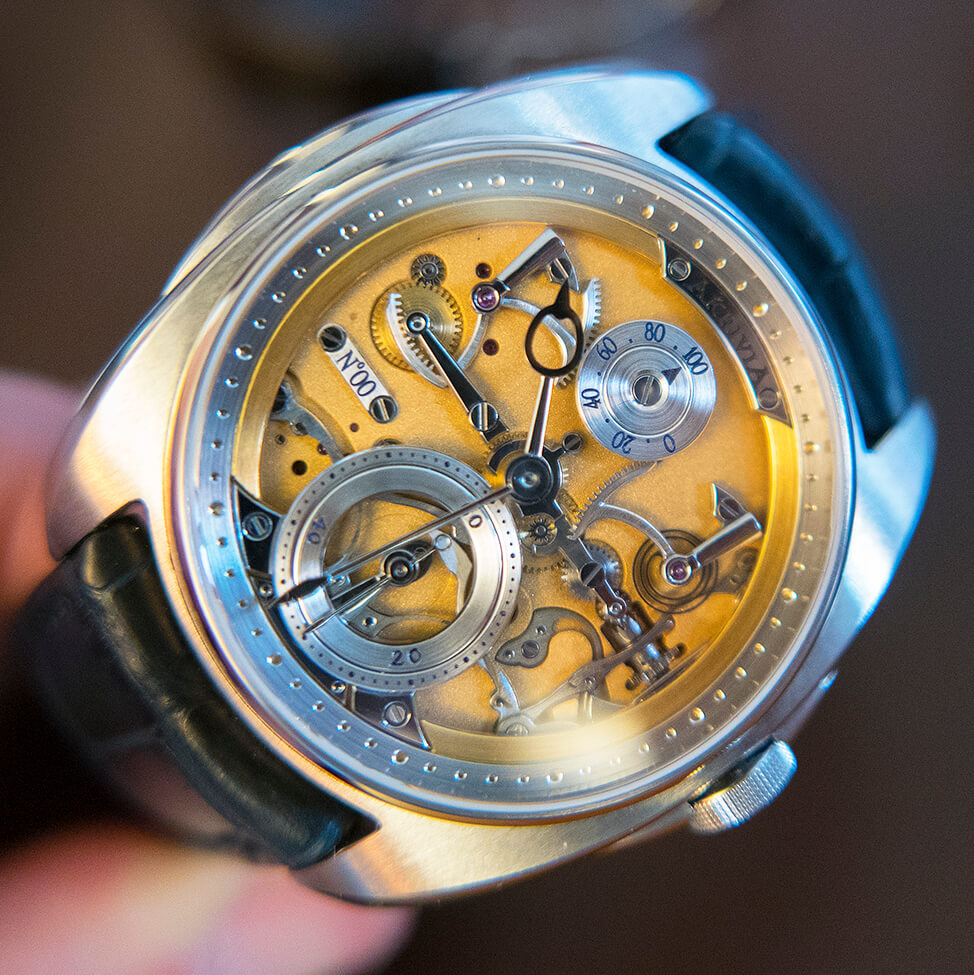
The Akrivia AK-06 at Baselworld 2017
For such a small and relatively new enterprise, the buzz around Akrivia has been remarkable, and the watches are pretty special, too.
However, the world of independent watchmaking is a tough place to make a living (see Why Independents Struggle), and there is no shortage of brilliant independent minds out there relative to the number of likely buyers for their highly specialized watches.
So, why might Akrivia move to the fore?
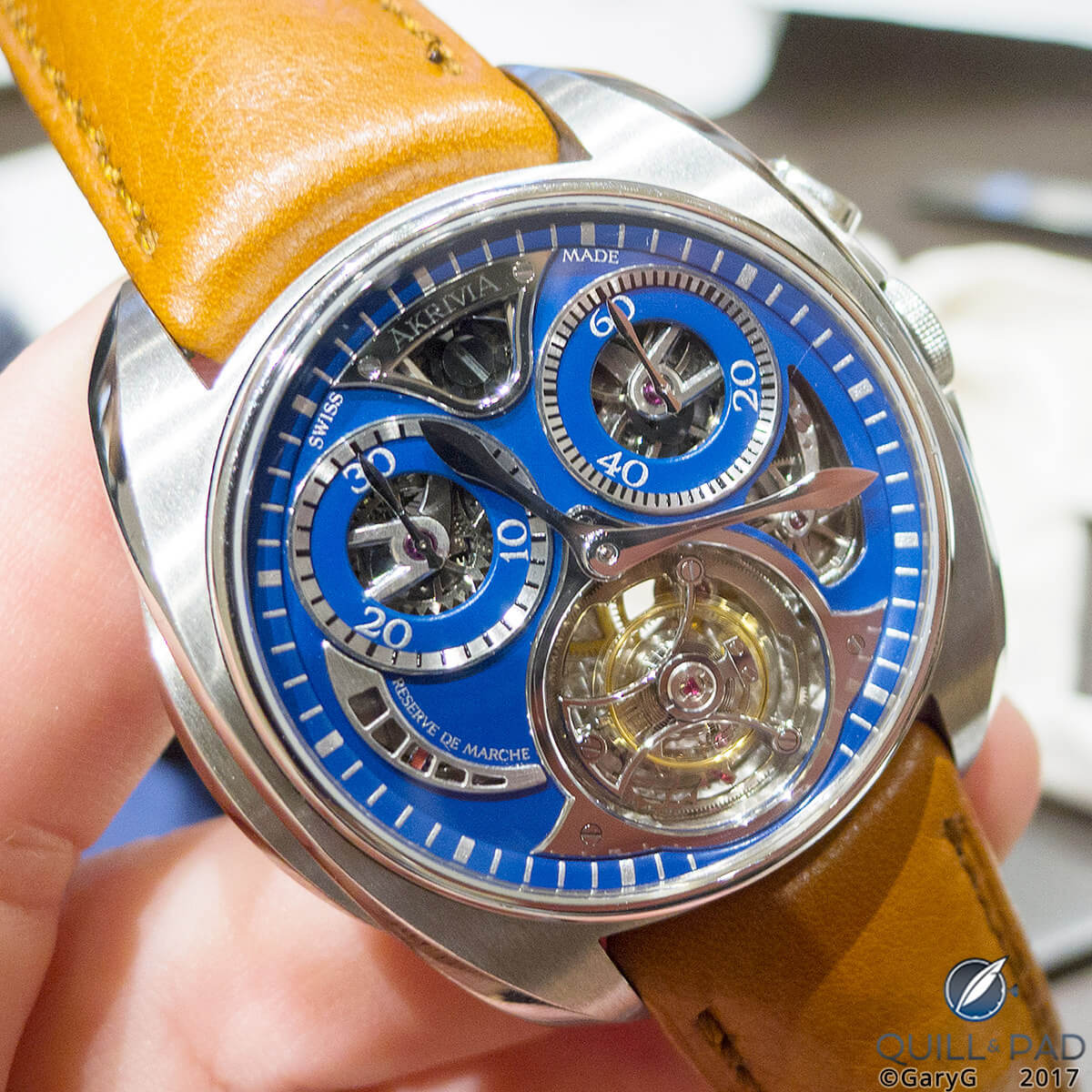
Living color: Akrivia Tourbillon Monopusher Chronograph
It’s all about the product
Years ago, the noted marketing channels expert Professor Lou Stern confided in me his three secrets of distribution channel strategy: “Product, product, and product!”
The premise, of course, is that if you’re selling something great, getting the attention of distributors and retailers and pull-through from enthusiastic consumers becomes much easier.
Rexhepi and Akrivia have delivered on the product front in a variety of ways.
No small plans: From the very beginning, Akrivia’s watches have featured complex mechanisms such as tourbillons at the core of its first five models and additional complications including jumping hours, chronographs, and chiming hours among others.
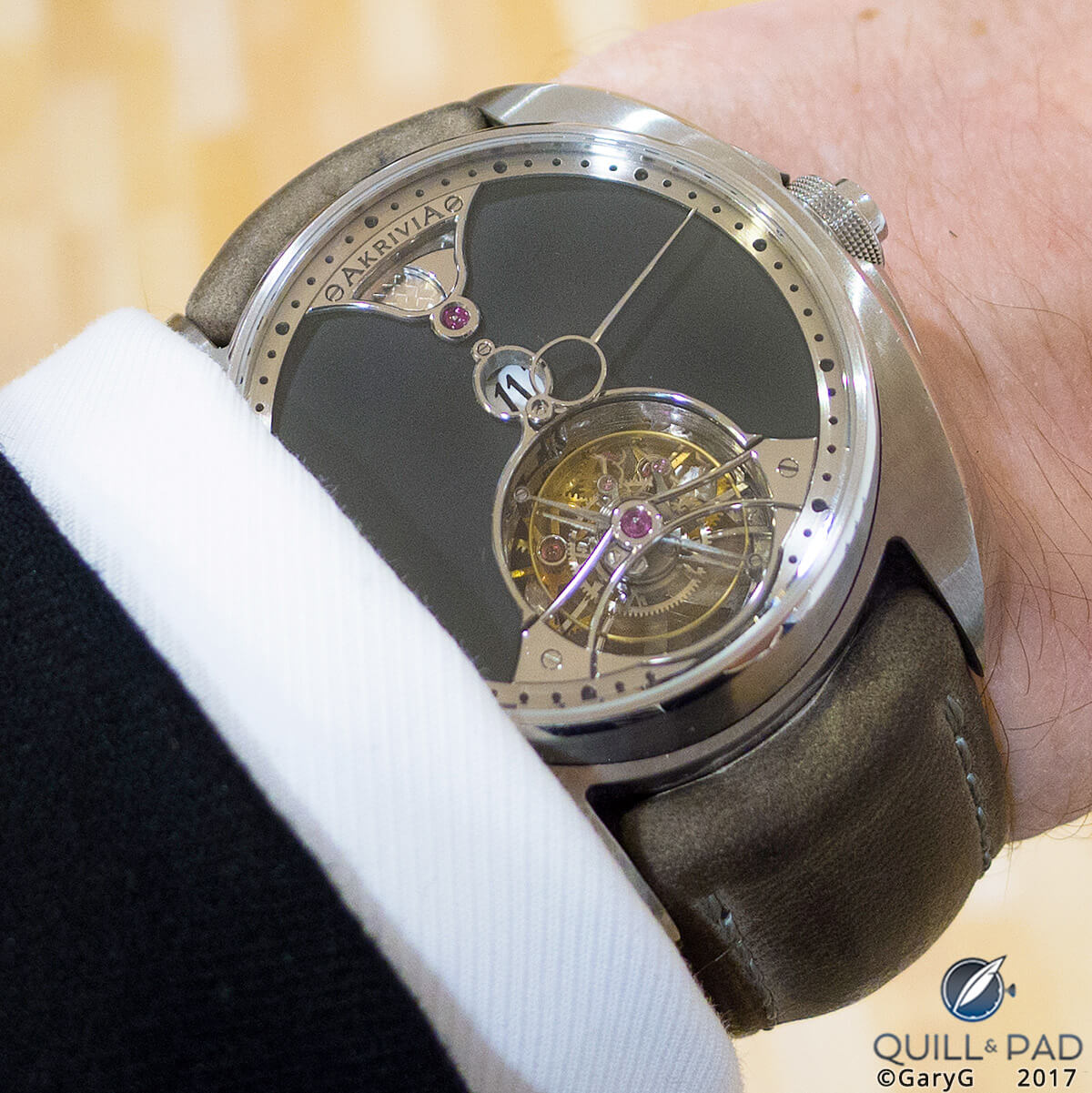
Tourbillon Chiming Jump Hour from Akrivia on the author’s wrist
Thoughtful migration: Akrivia’s first models were based on a pre-existing tourbillon caliber from (now defunct) BNB Concept; in fact, the foundation of the initial tourbillon chronograph was an ébauche also used in watches from Hublot, among others.
To that starting point, however, Akrivia added its own value, re-working the movement and adding sublime finishing and styling that to me is reminiscent of Kari Voutilainen’s use of calibers, including the Peseux 260, in his early pieces.
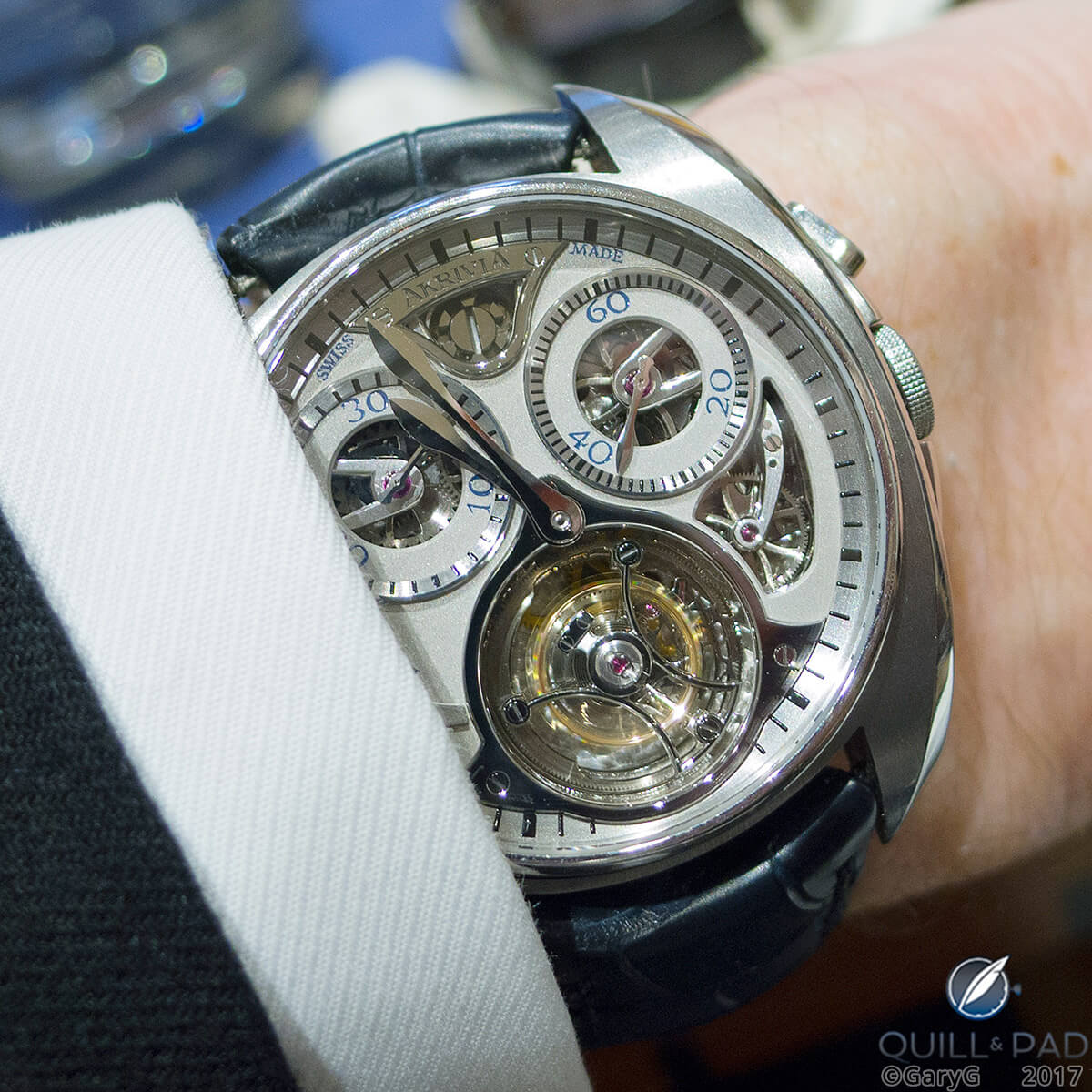
Akrivia Tourbillon Monopusher Chronograph
After several models based on the tourbillon architecture, in its fifth year Akrivia has now taken the big step of introducing its own internally developed movement with the dramatic AK-06.
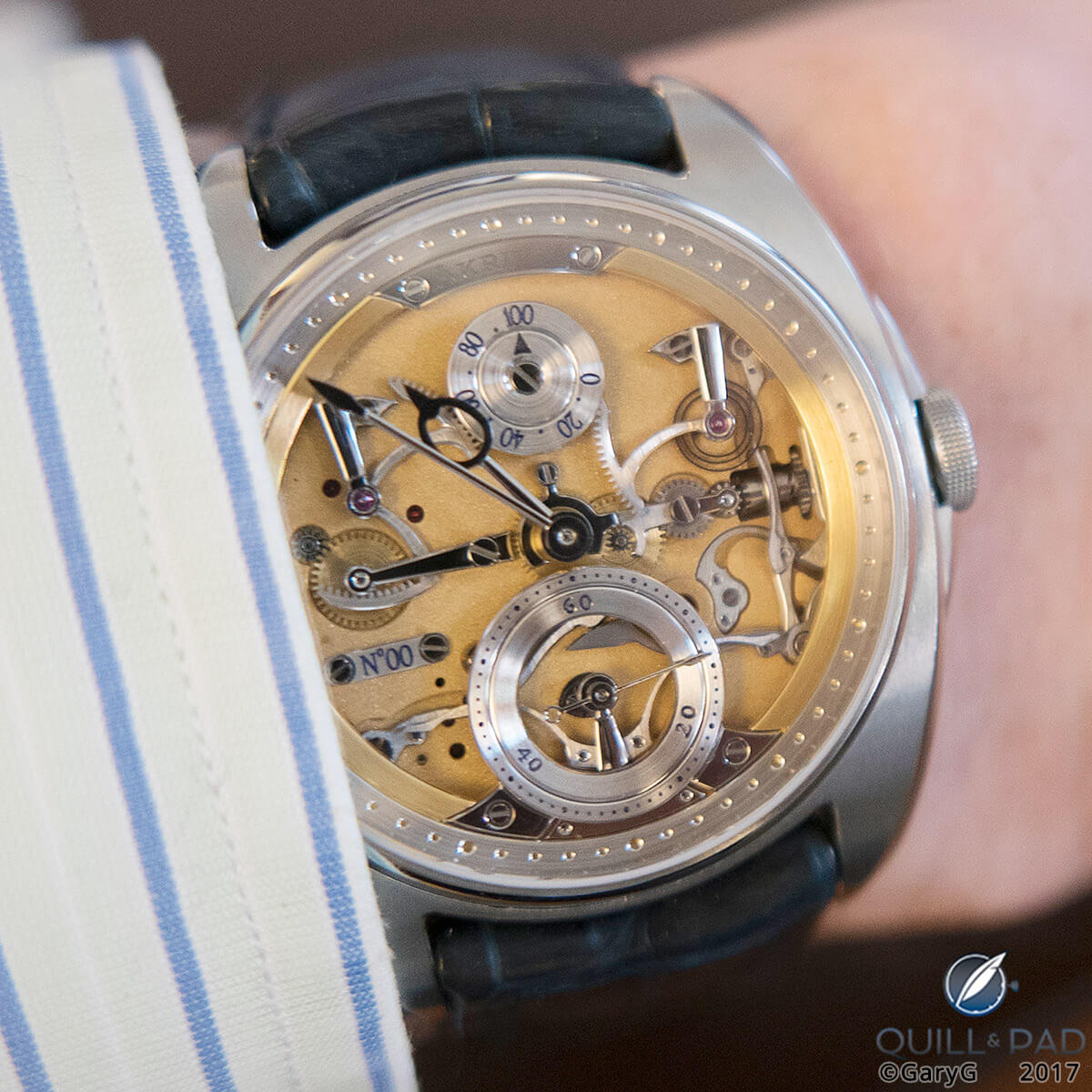
In-house beauty: Akrivia AK-06
Famous for finishing: While a number of independents are known for their excellent finishing work, Rexhepi has raised the ante almost to the level of a dare by designing his movements to require dozens – and in some cases more than fifty – sharply finished internal angles on the movement bridges and plates.
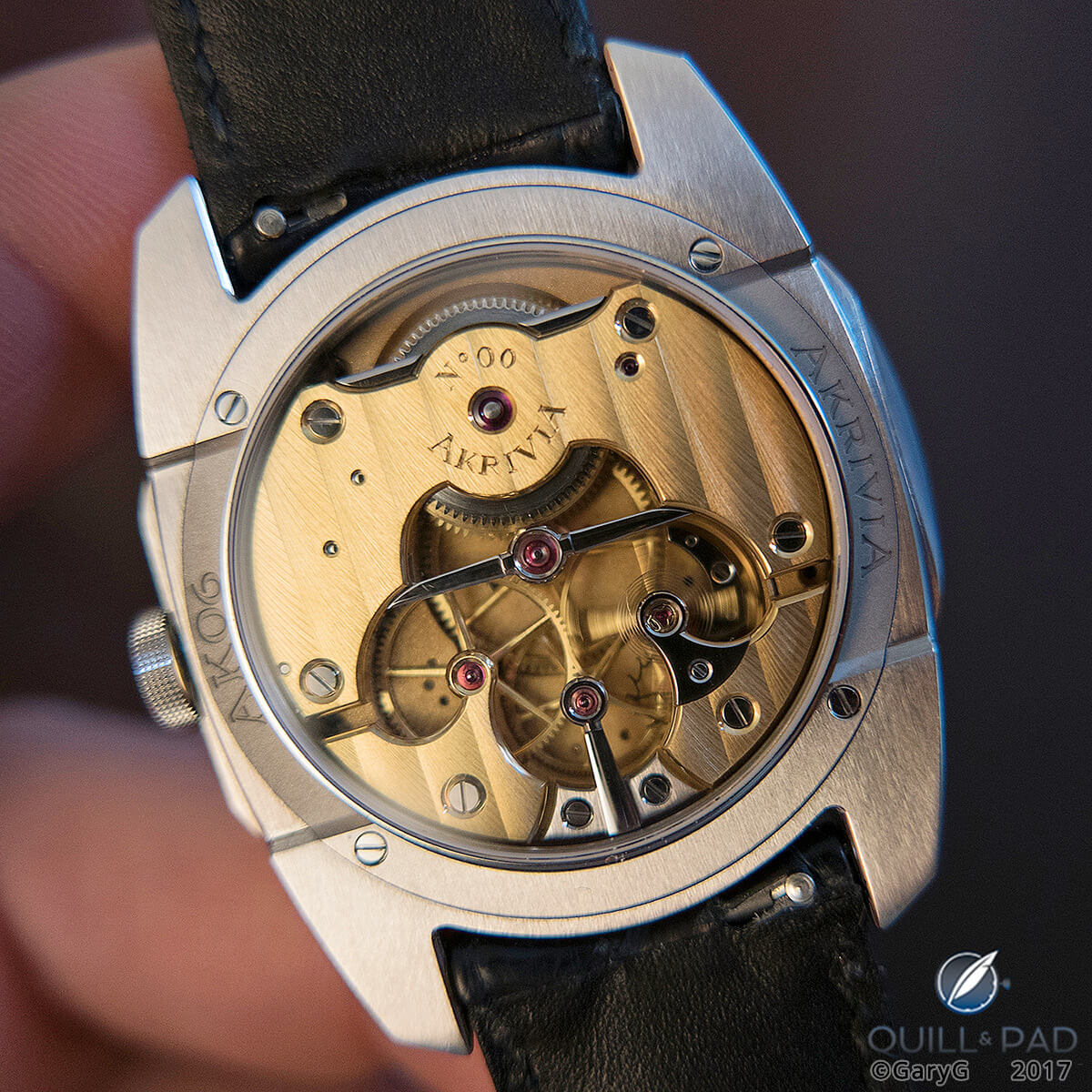
A joy to behold: sublime finishing and symmetrical design, reverse of Akrivia AK-06
Akrivia’s anglage is done in rounded bombé style, requiring additional skill and time, and the dial sides of his watches feature a dizzying variety of finishing alternatives including matte, highly polished, and hammered surfaces in various colors as well as black polishing and gorgeously blued numerals.
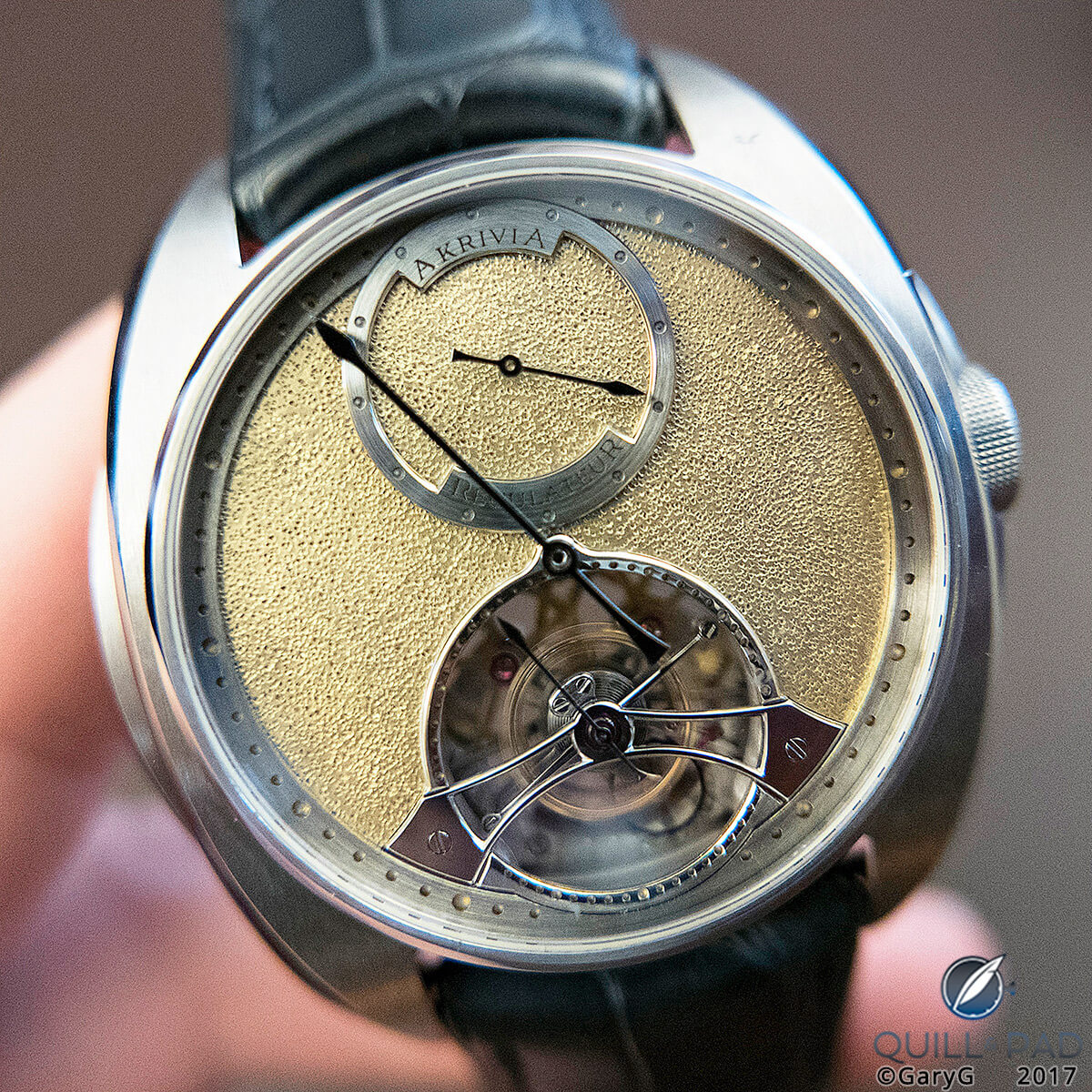
Hand-hammered gold dial, Akrivia Tourbillon Regulateur
At the same time, there’s enough “imperfect perfection” in elements such as the engraved inscriptions to make it obvious that these watches are clearly the product of laborious hand-working.

Handmade: movement detail, Akrivia Tourbillon Regulateur with hand-engraved plaques
Distinctiveness and consistency: It’s easy to recognize an Akrivia watch when you see one, and it’s not just the distinctively shaped case that gives it away. For instance, when it comes to movement architecture Rexhepi utilizes a consistent mechanical design language that depends heavily on symmetry and the use of signature elements such as an “epicentric” and highly visible center wheel.
With perhaps one exception that I’ll discuss below, Akrivia’s design rules aren’t a straightjacket: I’ve been pleased to see a variety of hand shapes, for instance, including both broad and almost needle-thin variants on hour and minute hands.
Inventiveness: The watches are just darned clever! This year’s AK-06 (my top watch pick at Baselworld 2017) might seem to be “just” a three-hand watch, but the dial-side power reserve features a novel construction that includes two-toothed racks and counter-rotating indicators, and the movement also features a zero-reset mechanism for the small seconds in the form of a heart-shaped cam visible at the center of the seconds subdial in the photo below.
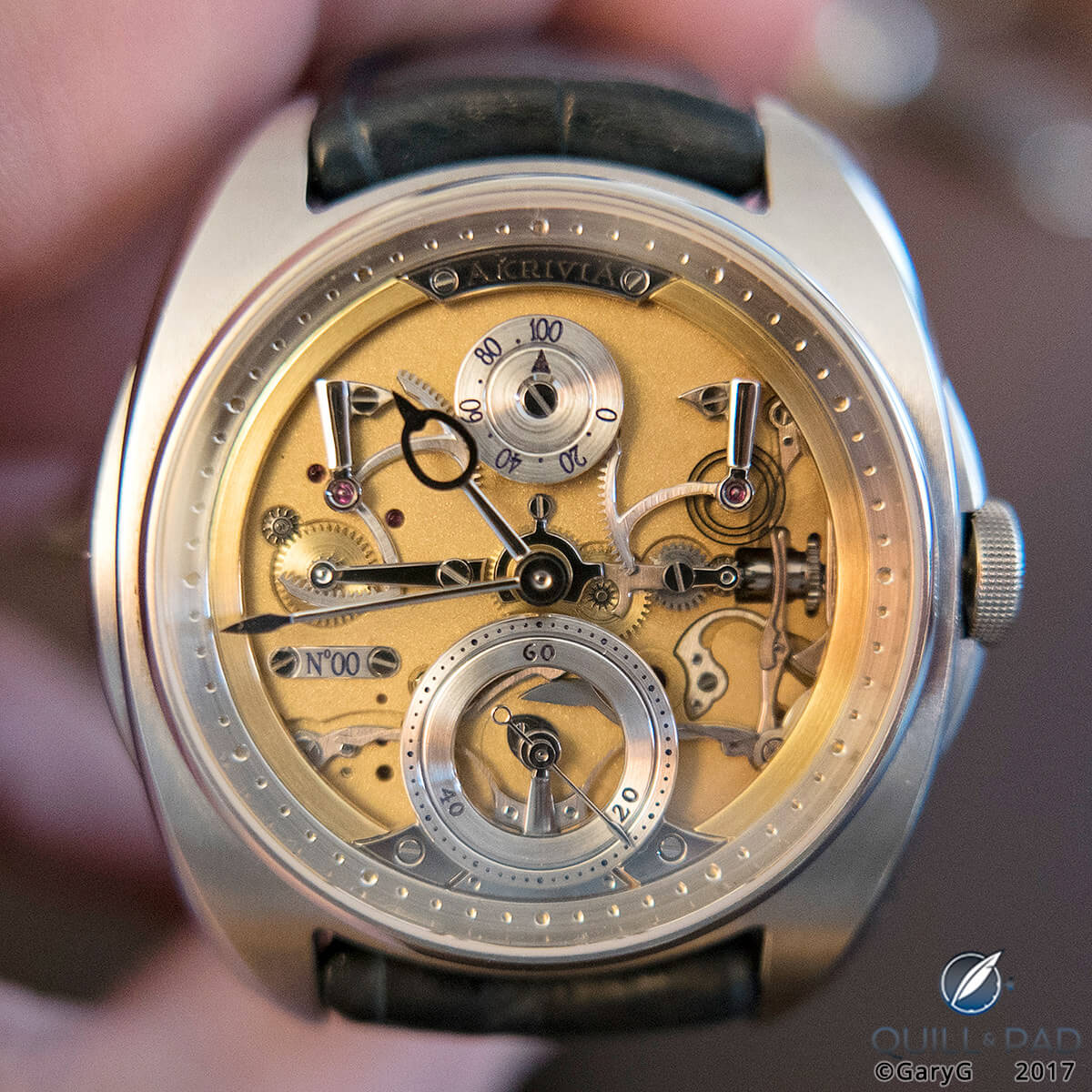
Akrivia AK-06 with heart cam for zero-reset at bottom center
It’s all about the people
For me, it’s generally true that the watch world is about its people, and doubly so when we are talking about the independents, where the physical products very directly reflect the experiences, perspectives, and personalities of their makers.
When it comes to experience, Rexhepi certainly has the needed pedigree, beginning with an apprenticeship at Patek Philippe and including stops along the way at BNB Concept and F.P. Journe before starting up Akrivia.
And his brother and colleague Xhevdet apprenticed at Patek Philippe as well.

Training ground: Rexhep Rexhepi’s Patek Philippe Montre Ecole
The brothers also have youth on their side, and as can be seen in their designs they also bring a youthful and refreshing perspective to watch aesthetics.
And as far as I can tell, there’s no shortage of dedication and plain old hard work, as Xhevdet’s online feeds in particular seem to feature a lot of late-night and weekend workshop shots!
It’s all about the promotion
Speaking of online feeds, one thing that has clearly helped to elevate Akrivia above the clutter is the use of several kinds of promotion.
Online presence: At the far extreme, while I’ve dealt with some independents who have sent me exactly zero in-progress photographs during the production of watches that I’ve commissioned, by contrast the Akrivia team seems to have an excellent understanding of the desire of today’s collectors to have behind-the-scenes access to the internal workings of their workshop as well as a steady stream of Instagram and Facebook posts of completed eye candy.
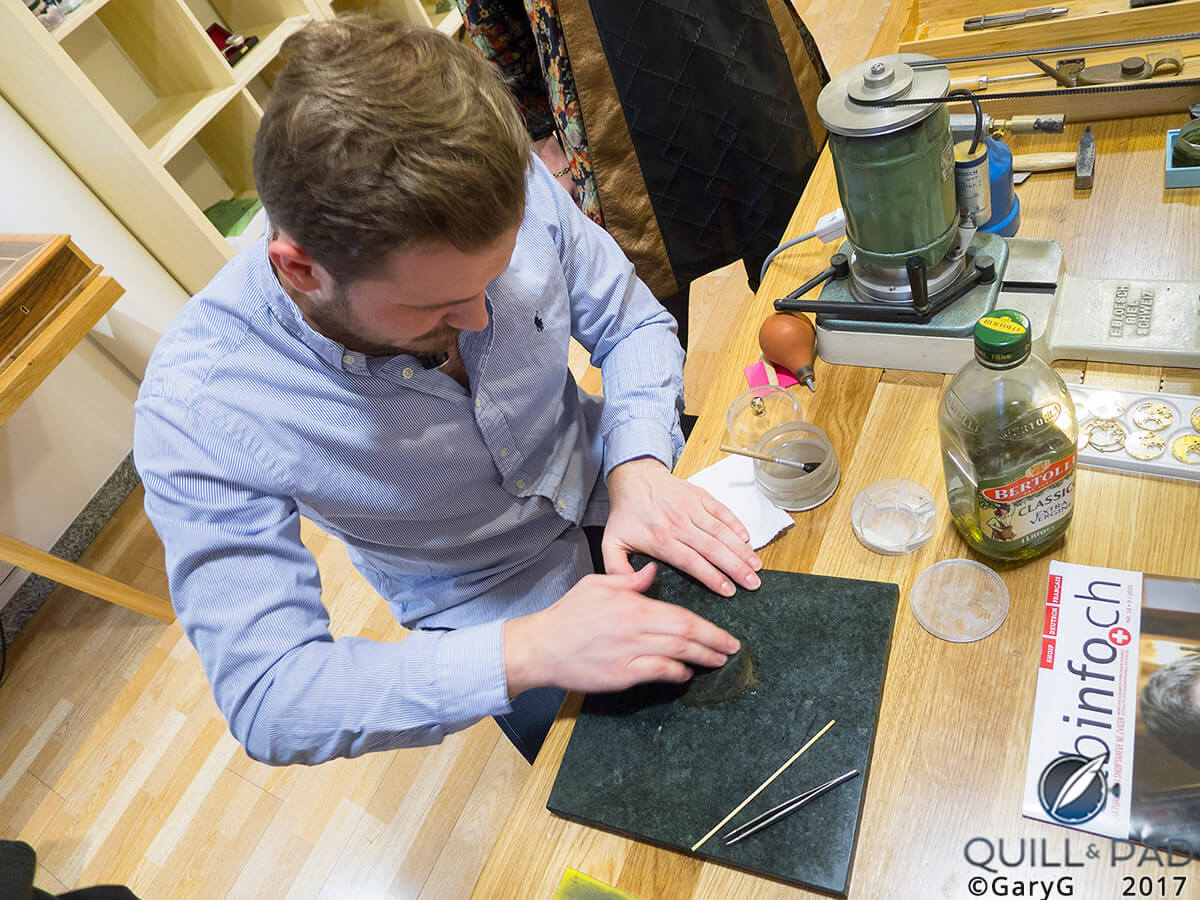
Live and in person: parts finishing demonstration at Akrivia’s Geneva workshop
In-person accessibility: Unlike most independents, Akrivia has its workshop in the heart of Geneva and eagerly greets visitors. When I’ve been there, the visit has prominently featured demonstrations of techniques like black polishing and flame bluing as well as opportunities to see the watchmakers’ ongoing work and handle multiple finished pieces.
And, of course, at the end of any visit there’s always the group photo of the “distinguished visitors” for online posting, linking the physical and virtual promotional worlds.

Example parts (not production items), bluing demonstration
Patronage and influence: While Akrivia does not intrude on the privacy of its buyers in its promotional materials, it’s well known in the collector community that a number of influential indie collectors have bought the micro brand’s timepieces; that’s the kind of promotion that can’t be bought, but is worth its weight in gold.
So what could possibly go wrong?
Akrivia has included some pretty non-traditional elements in its success formula to date, and while it seems to be working so far, there are perhaps a few clouds on the horizon.
Live by the promotion, die by the promotion: I think that it’s super that Akrivia is taking a twenty-first-century approach to marketing awareness, but particularly when it comes to more “mature” collectors, what one person might see as a fresh and transparent approach might be seen by others as in-your-face pushiness.
For instance, I know one noted collector who was considering a commission with Akrivia but felt he was being “sold” too aggressively and ultimately chose another option.
And, while the Akrivia team does a great job of staying current on social media, other online tools seem to suffer a bit: for instance, while the AkriviA website features a photo of yours truly with friends taken during our visit in 2016, there is still no information there about this year’s AK-06.
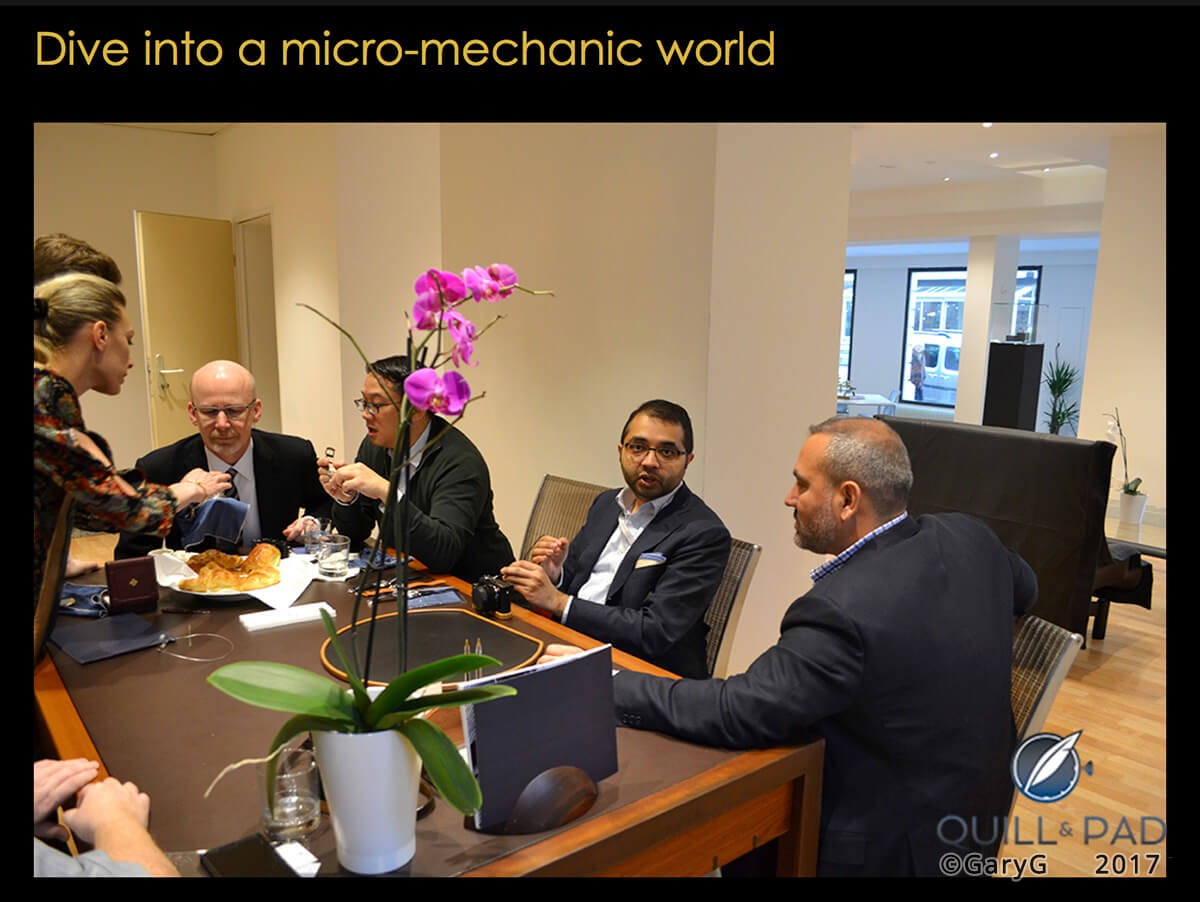
See the promotion, be the promotion: a photo of the author and friends on Akrivia’s website
Live by the case, die by the case: Earlier, I mentioned that Akrivia’s design codes don’t seem to be a straightjacket. One exception to that rule for me might be the design of their cases, which one can choose to see as either refreshingly modern or overly sporty.
I know that it’s a tough line to walk to be sufficiently flexible while avoiding being all things to all people; at the same time, even makers like Kari Voutilainen, who is known for his classic teardrop-lugged cases, have from time to time tried other shapes (as in the Voutilainen Caliber 27).
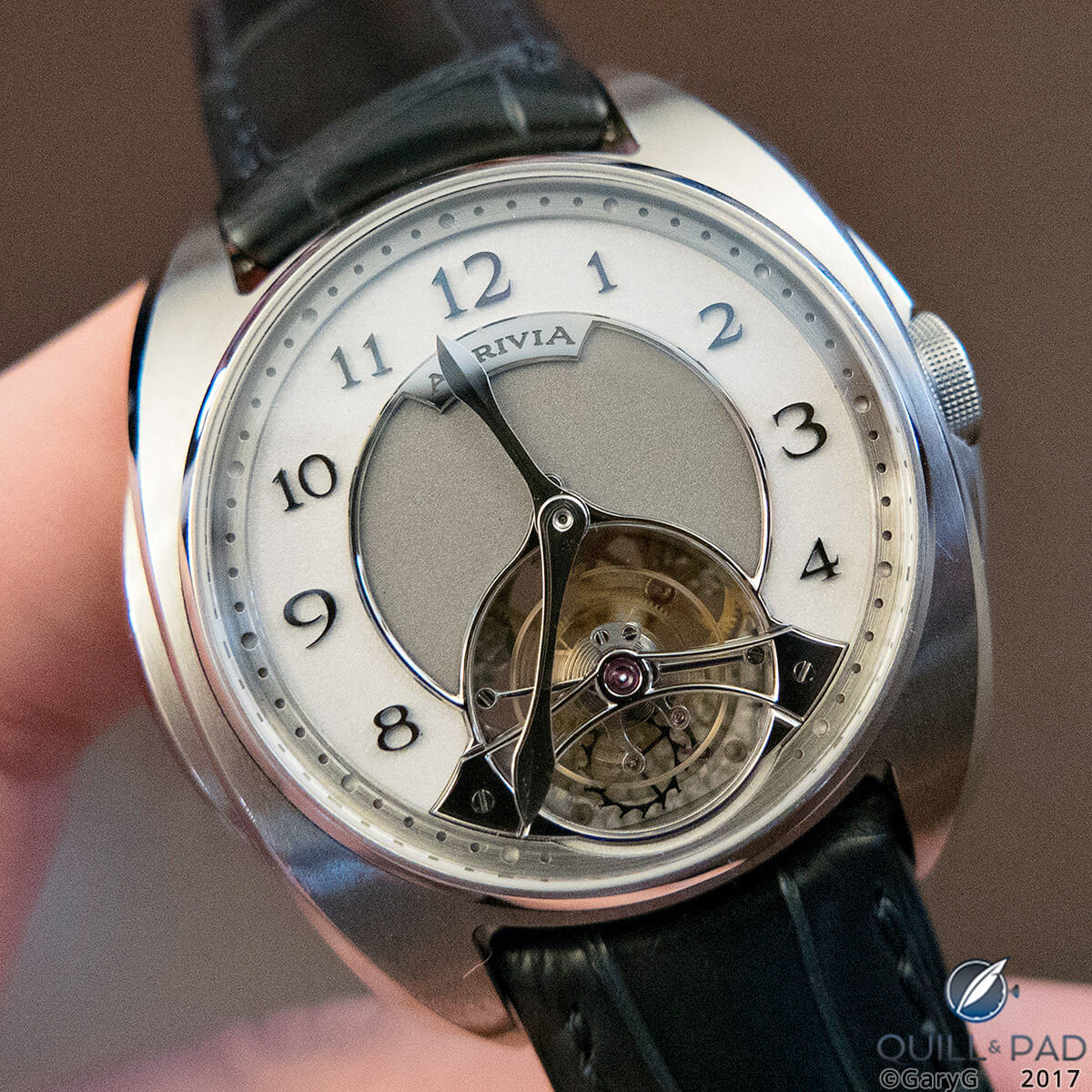
Uniformly recognizable: characteristic case shape of Akrivia watches, here on the Tourbillon Hour Minutes
Degrees of separation: In many ways, Rexhepi and Akrivia are standing apart from the crowd, and for the life of me I’m not quite certain whether that’s a brilliant strategy or a potentially limiting tactic.
In my heart of hearts I wish that Rexhepi would participate more directly in the community of independent watchmakers, but with actions such as locating at the Ramada rather than Les Ateliers at Baselworld and even the use of Akrivia as a brand identity rather than establishing an eponymous brand, he seems to have chosen an “independent independent” path.
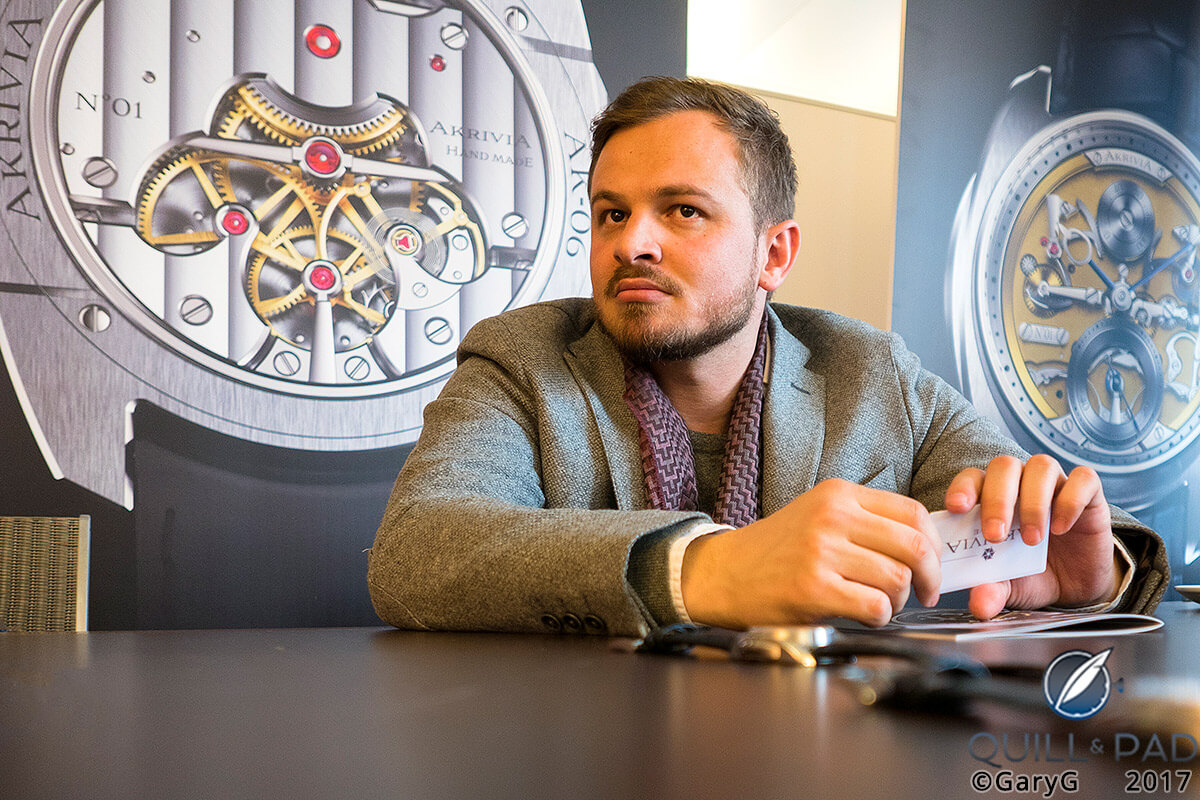
Charting an independent path: Rexhep Rexhepi of Akrivia
Critical mass: As I mentioned above, a number of influential collectors have hopped onto the Akrivia bandwagon; but over time will the brand pass the tipping point at which demand takes off and collectors aren’t concerned about “getting hurt” on watches that range in retail price from about $80,000 to more than $200,000?
I’ll be fascinated to see how the story unfolds whether Akrivia builds the foundation of loyal collectors and repeat buyers that it will require to fulfill the long-term potential of its brilliant watches and their equally brilliant makers.
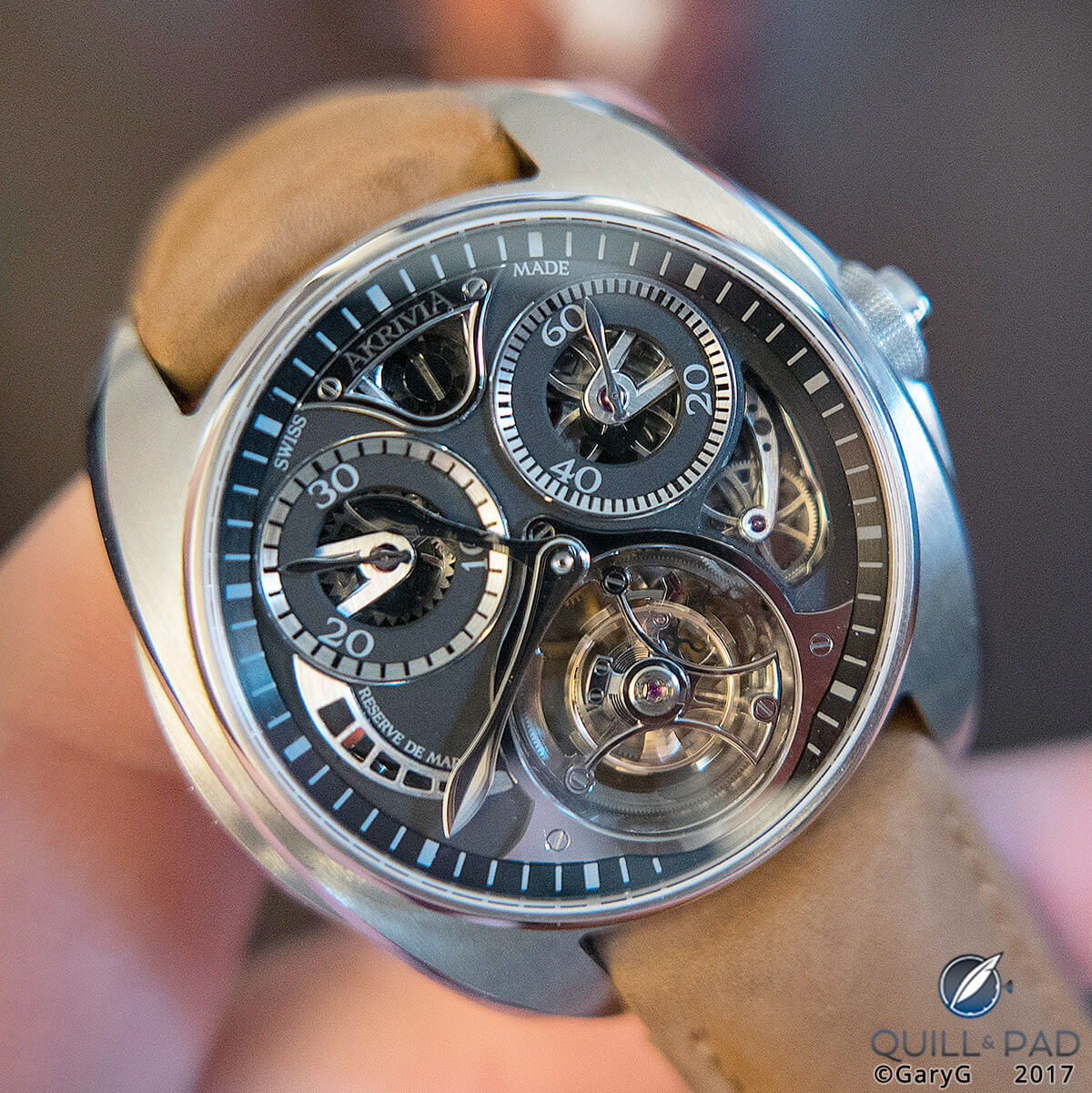
Parting shot: Akrivia Tourbillon Monopusher Chronograph
For more information, please visit www.akrivia.com.
Quick Facts Akrivia AK-06
Case: 41 x 9.9 mm, available in stainless steel, titanium, 5N red gold, or platinum
Dial: various dial finishes and colors available
Movement: manually wound Caliber AK-06; diameter 30.0 mm; hacking seconds and zero reset; Breguet overcoil; 18,000 vph, 100-hour power reserve
Functions: hours, minutes; subsidiary seconds; power reserve indicator
Price: 79,000 Swiss francs (steel) to 91,000 Swiss francs (titanium)
* This story was originally posted on June 17, 2017 at A Collector’s View: Is Akrivia Bound For Glory?
You may also enjoy:
Why I Bought It: Rexhep Rexhepi/Akrivia Chronomètre Contemporain
Akrivia Tourbillon Chiming Jump Hour: Manifest Destiny Or Gut Feeling?
Baselworld 2017 Round Table: What We Liked And What We Didn’t Like





















































Leave a Reply
Want to join the discussion?Feel free to contribute!